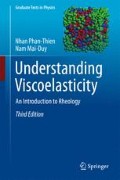Abstract
In isothermal flow where the conservation of energy is not relevant, there are four scalar balance equations (one conservation of mass and three conservation of linear momentum), and there are 10 scalar variables (3 velocity components, one pressure, and 6 independent stress components – thanks to the conservation of angular momentum, the stress tensor is symmetric). Clearly we do not have a mathematically well-posed problem until 6 extra equations are specified.
Access this chapter
Tax calculation will be finalised at checkout
Purchases are for personal use only
Notes
- 1.
The terminology is due to M. Reiner.
- 2.
James G. Oldroyd (1921–1982) was a Professor in Applied Mathematics at Universities of Wales and Liverpool. He made several important contributions to the constitutive equation formulation. The Oldroyd fluids (fluid A and fluid B) were named after him.
Author information
Authors and Affiliations
Corresponding author
Problems
Problems
Problem 4.1
In a simple shear deformation of a linear elastic material (4.7), the displacement field takes the form
where \(\gamma \) is the amount of shear. Find the elastic stress, in particular, the shear stress. This justifies calling \(\mu \) the shear modulus.
Problem 4.2
In a uni-axial extension of a linear elastic material (4.7), the displacement field is given by
where \(\varepsilon \) is the elongational strain, and \(\nu \) is the amount of lateral contraction due to the axial elongation, called Poisson’s ratio. If the lateral stresses are zero, show that
where E is the Young’s modulus, i.e., \(T_{xx}=E\varepsilon .\)
Problem 4.3
Show that a material element \(d\mathbf {X}=dX\mathbf {P},\) where \(\mathbf {P}\) is a unit vector, is stretched according to
where \(\mathbf {C}\) is the right Cauchy-Green tensor. Thus when \(\mathbf {P}\) is randomly distributed in space, the average amount of stretch is
and therefore \(\frac{1}{3}\mathrm {tr}\mathbf {C}\) can be used as a definition of the Weissenberg number.
Problem 4.4
Let \(\mathbf {f}\) be a vector-valued, isotropic polynomial of a symmetric tensor \(\mathbf {S}\) and a vector \(\mathbf {v}.\) Use the integrity basis in (4.36) to prove that
where the scalar valued coefficients are polynomials in the six invariants involving only \(\mathbf {S}\) and \(\mathbf {v}\) in the list (4.36).
Problem 4.5
Consider a simple shear deformation of a rubber-like material (4.55), where
Show that the Finger strain tensor \(\mathbf {B}\) and its inverse are given by
Consequently, show that the stress tensor is given by
where P is the hydrostatic pressure. Thus, show that the shear stress and the normal stress differences are
Deduce that the linear shear modulus of elasticity is
The ratio
is independent of the material properties. Such a relation is called universal.
Problem 4.6
In a uniaxial elongational deformation of a rubber-like material (4.55), where (in cylindrical coordinates)
show that the inverse deformation gradient is
Consequently, the Finger strain tensor \(\mathbf {B}\) and its inverse \(\mathbf { B}^{-1}\) are
Thus the total stress tensor for a rubber-like material (4.55) is
Under the condition that the lateral tractions are zero, i.e., \(T_{rr}=0\), the pressure can be found, and thus show that the tensile stress is
This tensile stress is the force per unit area in the deformed configuration. As \(r=\lambda ^{1/2}R,\) the corresponding force per unit area in the undeformed configuration is
Problem 4.7
Show that
Problem 4.8
Consider a simple shear flow
Show that the stress tensor in the second-order model is given by
Thus, the three viscometric functions are
Problem 4.9
Consider a second-order fluid in an elongational flow
Show that the stress is given by
Consequently the elongational viscosity is given by
Problem 4.10
Show that, for potential flows,
Problem 4.11
For steady two-dimensional incompressible flows, a stream function \(\psi =\psi (x, y)\) can be defined such that the velocity components u and v can be expressed as
Obtain the stresses in a second-order fluid in terms of \(\psi \). Substitute the stresses into the equations of motion and eliminating the pressure term through the use of the equality of the mixed partial derivatives, i.e., \( p_{,xy}=p_{, yx},\) to obtain
where \(\triangle ^{2}\) is the two-dimensional biharmonic operator. Deduce that a Newtonian velocity field is also a velocity field for the second-order fluid. The result is due to Tanner [83].
Problem 4.12
In a simple shear flow,
show that the path lines \(\varvec{\xi }\left( \tau \right) =\left( {\xi ,\psi ,\zeta }\right) \) are given by
where
Find the relative strain tensor, the stress tensor for a finite viscoelastic integral fluid, and show that the shear stress and the normal stress differences are given by
Investigate the case where the shear rate is constant and sinusoidal in time for the memory function in (4.88).
Rights and permissions
Copyright information
© 2017 Springer International Publishing AG
About this chapter
Cite this chapter
Phan-Thien, N., Mai-Duy, N. (2017). Constitutive Equation: General Principles. In: Understanding Viscoelasticity. Graduate Texts in Physics. Springer, Cham. https://doi.org/10.1007/978-3-319-62000-8_4
Download citation
DOI: https://doi.org/10.1007/978-3-319-62000-8_4
Published:
Publisher Name: Springer, Cham
Print ISBN: 978-3-319-61999-6
Online ISBN: 978-3-319-62000-8
eBook Packages: Physics and AstronomyPhysics and Astronomy (R0)

